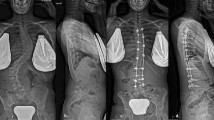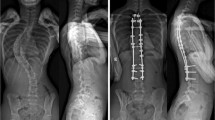Abstract
Purpose
To report an original technique for the surgical correction of adolescent idiopathic scoliosis (AIS) based on hybrid construct using polyester bands placed under the thoracic transverse processes.
Methods
We reviewed 105 patients operated between 2013 to 2017 for AIS with a minimum of 2 years follow-up. Clinical and radiological data, including 2D measurements of scoliosis parameters preoperatively, and at 3- and 24-months postoperatively were analyzed. Radiological analysis was performed by two independent observers using KEOPS (Smaio, Lyon-France, CE 2014) database.
Results
Mean age was 14.6 ± 2 years. Mean follow-up was 23.7 ± 1.2 months. Most curves were classified as Lenke-1 (78%). The average number of vertebra involved in the construct was 10.9 ± 1.3 (range 7–13). A mean of 12.8 implants were used per construct (mean implant density 0.59). The number of subtransverse bands placed averaged 3 (range 1–5 bands).
The mean frontal Cobb angle decreased from 57.9 to 21.2 ° (p < 0.05) postoperatively. The average T4-T12 kyphosis increased from 20.2°to 32.4° (p < 0.05) postoperatively and no loss of correction was observed at 2 years follow-up. We encountered one case of transverse process fracture intraoperativley. No neurological complications were observed. In the postoperative period, 4 cases were diagnosed with distal junctional failure, three of which required an extension of the construct, while the fourth case was treated by bracing.
Conclusions
The use of subtransverse band is an efficient and safe method for the surgical correction of AIS. This technique incorporates technical ease (minimal risk of neurological injury), provides good frontal correction and restores thoracic kyphosis. Results are maintained over a two-year period.


Similar content being viewed by others
Data availability
The authors confirm that the data supporting the findings of this study are available within the article [and/or] its supplementary materials.
References
Ledonio CGT, Polly DW Jr, Vitale MG, Wang Q, Richards BS (2011) Pediatric pedicle screws: comparative effectiveness and safety: a systematic literature review from the Scoliosis Research Society and the Pediatric Orthopaedic Society of North America task force. J Bone Joint Surg Am 93:1227–1234
Winter RB, Lonstein JE, Denis F (2007) How much correction is enough? Spine 32:2641–2643
Fletcher ND, Hopkins J, Mc Clung A, Browne R, Sucato DJ (2012) Residual thoracic hypokyphosis after spinal fusion and instrumentation in adolescent idiopathic scoliosis: risk factors and clinical ramifications. Spine 37(3):200–206
Mazda K, Ilharreborde B, Even J, Lefevre Y, Fitoussi F, Pennecot G-F (2009) Efficacy and safety of posteromedial translation for correction of thoracic curves in adolescent idiopathic scoliosis using a new connection to the spine: the Universal Clamp. EurSpine J 18:158–169
Clement J-L, Chau E, Kimkpe C, Vallade M-J (2008) Restoration of thoracic kyphosisby posterior instrumentation in adolescent idiopathic scoliosis: comparative radiographic analysis of two methods of reduction. Spine 33:1579–1587
Ilharreborde B, Even J, Lefevre Y, Fitoussi F, Presedo A, Pennecot G-F et al (2010) Hybrid constructs for tridimensional correction of the thoracic spine in adolescent idiopathic scoliosis: a comparative analysis of universal clamps versus hooks. Spine 35:306–314
Sales de Gauzy J, Jouve JL, Accadbled F, Blondel B, Bollini G (2011) Use of the Universal Clamp in adolescent idiopathic scoliosis for deformity correction and as an adjunct to fusion: 2-year follow-up. J Child Orthop 5:273–282
Hongo M, Ilharreborde B, Gay RE, Zhao C, Zhao KD, Berglund LJ et al (2009) Biomechanical evaluation of a new fixation device for the thoracic spine. Eur Spine J 18:1213–1219
Wilber RG, Thompson GH, Shaffer JW, Brown RH, Nash CL Jr (1984) Postoperative neurological deficits in segmental spinal instrumentation. A study using spinal cord monitoring. J Bone Joint Surg Am 66:1178–1187
Bridwell K (1997) Spinal instrumentation in the management of adolescent scoliosis. Clin Orthop Relat Res 335:64–72
Johnston CE II, Happel LT Jr, Norris R, Burke SW, King AG, Roberts JM (1986) Delayed paraplegia complicating sublaminar segmental spinal instrumentation. J Bone Joint Surg Am 68:556–563
Thometz JG, Emans JB (1988) A comparison between spinous process and sublaminar wiring combined with Harrington distraction instrumentation in the management of adolescent idiopathic scoliosis. J Pediatr Orthop 8:129–132
Hirsch C, Ilharreborde B, Fournier J, Mazda K, Bonnard C (2014) Adolescent idiopathic scoliosis correction achieved by posteromedial translation using polyester bands: a comparative study of subtransverse process versus sublaminar fixation. Orthop Traumatol Surg Res 100:791–795
Wenger D, Miller S, Wilkerson J (1982) Evaluation of fixation sites for segmental instrumentation of the human vertebrae. Orthop Trans 6(23–24):19
Maillot C, Ferrero E, Fort D, Heyberger C, Le Huec J-C (2018) [2015] Reproducibility and repeatability of a new computerized software for sagittal spinopelvic and scoliosis curvature radiologic measurements: keops®. Eur Spine J 24:1574–1581
Akmeşe R, Us K (2013) Comparison of subtransverse process wiring and sublaminar wiring in the treatment of idiopathic thoracic scoliosis. J Spinal Disord Tech 26(2):79–86
Kemal Us A, Yilmaz C, Altay M, Yavuz OY, Sinan BS (2001) Subtransverse process wiring: a new technique of segmental spinal fixation of the thoracic spine or in the treatment of adolescent idiopathic scoliosis. Spine 26:2392–2396
Fujita M, Diab M, Xu Z, Puttlitz CM (2006) A biomechanical analysis of sublaminar and subtransverse process fixation using metal wires and polyethylene cables. Spine 31:2202–2208
Quan GM, Gibson MJ (2010) Correction of main thoracic adolescent idiopathic scoliosis using pedicle screw instrumentation: does higher implant density improve correction? Spine (Phila Pa1976) 35:562–567
Cheng I, Kim Y, Gupta MC, Bridwell KH, Hurford RK, Lee SS et al (2005) Apical sublaminar wires versus pedicle screws—Which provides better results for surgical correction of adolescent idiopathic scoliosis? Spine 30:2104–2112
Newton PO, Yaszay B, Upasani VV, Pawelek JB, BastromTP LLG, Lowe T, Crawford A, Betz R, Lonner B (2010) Preservation of thoracic kyphosis is critical to maintain lumbar lordosis in the surgical treatment of adolescent idiopathic scoliosis. Spine 35:1365–1370
Pesenti S, Lafage R, Henry B et al (2020) Deformity correction in thoracic adolescent idiopathic scoliosis. Bone Joint J. 102-B(3):376–382
Csernatony Z, Molnar S, Hunya Z, Mano S, Kiss L (2011) Biomechanical examination of the thoracic spine—The axial rotation moment and vertical loading capacity of the transverse process. J OrthopRes 29:1904–1909
Ilharreborde B, Pesenti S, Ferrero E et al (2018) Correction of hypokyphosis in thoracic adolescent idiopathic scoliosis using sublaminar bands: a 3D multicenter study. Eur Spine J 27:350–357
Mac-Thiong JM, IbrahimS PS, Labelle H (2017) Defining the number and type of fixation anchors for optimal main curve correction in posterior surgery for adolescent idiopathic scoliosis. Spine J 17(2017):663–670
Funding
The authors received no specific funding for this work.
Author information
Authors and Affiliations
Corresponding author
Ethics declarations
Conflicts of interest
All the authors state that they have no conflicts of interest.
Consent to participate
Informed consent was obtained from legal guardians.
Consent to publish
The authors affirm that human research participants provided informed consent for publication of the images in Figure(s) 2a, 2b and 2c.
Ethics approval
Institutional ethical clearance (study institutional registry n° 2020_090) was obtained before starting this retrospective study.
Additional information
Publisher's Note
Springer Nature remains neutral with regard to jurisdictional claims in published maps and institutional affiliations.
Rights and permissions
About this article
Cite this article
Zaher, A., El Youssef, K., Decourtivron, B. et al. Efficacy of polyester bands placed under the transverse vertebral process for the correction of adolescent idiopathic scoliosis. Eur Spine J 30, 1959–1964 (2021). https://doi.org/10.1007/s00586-021-06841-0
Received:
Revised:
Accepted:
Published:
Issue Date:
DOI: https://doi.org/10.1007/s00586-021-06841-0




